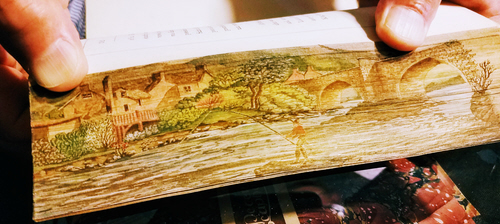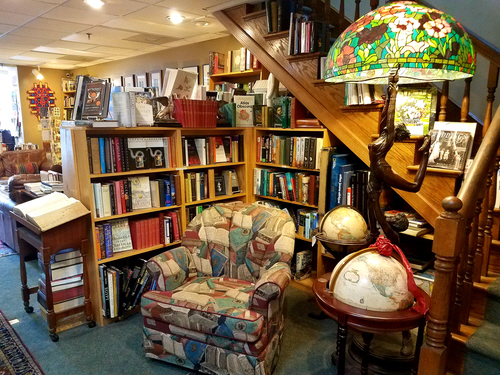
HV Morton was in the habit of using caricatures of certain groups of individuals as foils for his carefree narrator, enabling him to make a point in a lighthearted way, in keeping with the nature of his travelogues. The travelling salesman came in for a bit of stick on occasions, as did the ‘yokel’. But one of his favourites was the hapless American Tourist. Morton would paint him as naive and well-meaning, camera in hand, shutter clicking and uttering phrases such as ‘gee’ and ‘say, mister’. He would generally have daughters with names like Maisie, who would refer to him as ‘Dad!’ Well, that’s the male version certainly; of the female version, HVM was generally more complimentary. These unsuspecting individuals would provide ample opportunity for Morton’s traveller to expound fulsomely on a variety of topics as the reader pictures with amusement his assumed look of Old World superiority, the Tourist looking on, basking in his erudition.
However, in the years between the wars when Morton was writing about the British Isles, the world was growing steadily smaller. His books were such great successes in his mother-country, inevitably the lure of the even more lucrative American market began to exert its pull in a way that must have been difficult to resist. Morton was approached by North American publishers, with a view to expanding his readership (and his bank-balance) on the other side of the pond and the first US edition of “In Search of England” appeared as early as 1928 from publishers including the National Travel Club, and McBride, both of New York, and later Dodd, Mead and Co., also of New York.
But what to do about all those references to the American Tourist? All very amusing to a homespun readership certainly, but how would his irreverence be taken in the United States, already well on its way to supplanting the British Empire as the global superpower to be reckoned with? One can only imagine the mental gymnastics which must have gone on and the negotiations which must have been had prior to the publication of the first US edition.
We can get an insight into the thought process from the introduction Morton wrote to a 1935 revised US edition of “In Search of England”, published by Dodd, Mead and Co. and featured below for your interest. It seems at one point he considered expunging the offending references altogether but in the end decided that a bit of ‘context’ in the introduction might do the job instead. This introduction makes fascinating reading – never has back-pedalling been undertaken so elegantly. As you read it you will see that Morton has apparently always thought of the American Tourist as ‘loveable’ and ‘part of the English scene’ and he explains how he really misses them, now that the post-First World War travel boom was over.
And well might Maisie’s ‘Dad’ have responded, ‘Pull the other one, Limey!’

The cover of my Dodd, Mead and Co. edition of “In Search of England”
‘Introduction to the Revised Edition
‘WHEN Messrs. Dodd, Mead and Company asked me to revise for the United States this new edition of “In Search of England”, I was faced with the task of reading the book. I had no idea, when I wrote it some years ago, that the book would become a best-seller.
In fact, I never thought of such things. I just wanted to put down on paper the day-to-day impressions of a high-spirited journey over the roads and through the lanes of England. But, in the inexplicable way these things happen, “In Search of England”, with no assistance from the critics, began to sell all over the English-speaking world.
‘Reading it again at the request of Mr. Dodd, I am delighted to discover that it possesses two of the qualities by which I judge a book of travel: it deals sincerely with the unchanging and abiding things, and it is flavoured, but not too highly, by the time in which it was written.
‘This brings me to the only serious criticism I have received from readers in the United States. These criticisms are always the same. “Why,” I am asked, “do you draw such revolting Americans? All Americans are not vulgar. All Americans are not Babbitts. No Americans talk the kind of slang you put into their mouths.” And so forth.
‘I have received so many letters in this strain that my first reaction to Mr. Dodd’s revised edition was the desire to cut out every American in the book. But, as my pen hovered over these “guys,” I could not bring myself to do it. They are part of the English scene as it was when the book was written.
‘I went in search of England during that brief, golden age after the War when the Rue de Rivoli was an American possession, and when every English cathedral city received its daily quota of visiting Americans. These travellers were drawn very largely from a type that had never before strayed so far from home. Money had suddenly come their way and they were out to see the world. They did talk slang, and they did observe a lovable naivete which is faithfully reproduced here and there in these pages. For instance, the man encountered in Peterborough, who was making a cultural tour of Europe, could not be met with anywhere to-day, but he was an interesting phenomenon during the post-war travel boom. Therefore I ask my readers to understand that I am not setting up characters in any way typical of a nation, and if I were writing this book to-day not one of these people would appear in it, because they have ceased to brighten the rural life of England; much, I confess, to England’s regret.
‘But the England of these pages is still the England of to-day. The changes that have taken place are purely superficial. No Cornish farmer now listens to radio from London with a primitive valve set, and the old Mauretania has ceased to slip into Plymouth Sound.
‘Nevertheless the ancient background of the picture is unaltered. Jack Blandiver still kicks up his heels against the bell in Wells Cathedral, and Hadrian’s Wall still runs its solitary course into the mists of the northern fells.’
H. V. M., London, 1935.
Niall Taylor, Glastonbury, Somerset, England
(this article was originally circulated as HVM Society Snippets – No.195 on 3rd December 2015)






